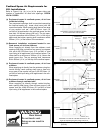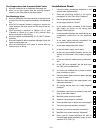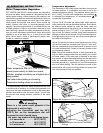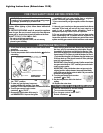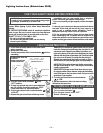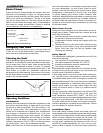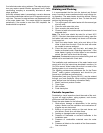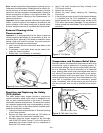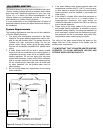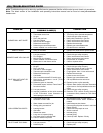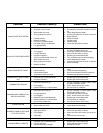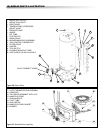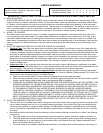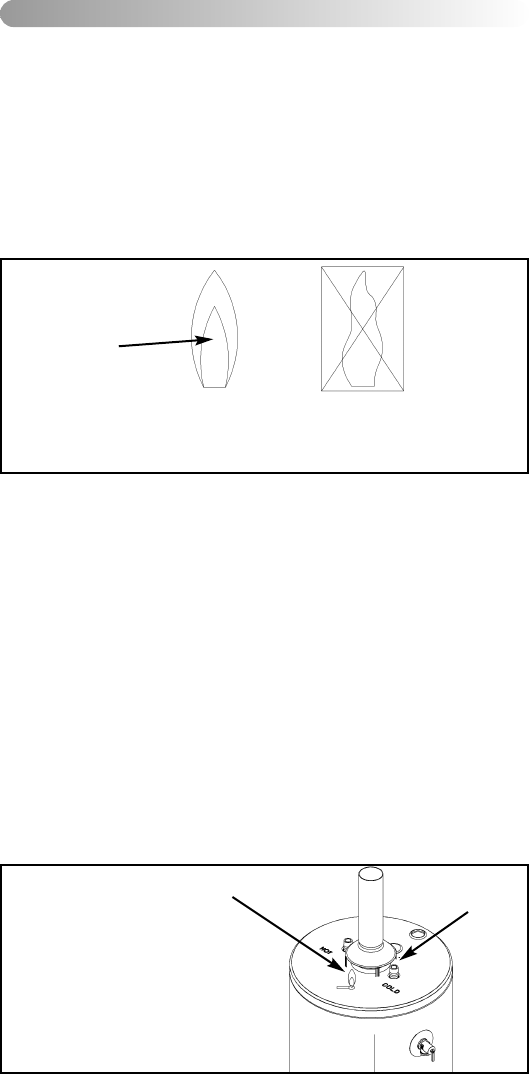
V) OPERATION
Burner Flames
Inspect the burner flames through the viewport and com-
pare them to the drawings in Figure 14. A properly operat-
ing burner should produce a soft blue flame. Blue tips with
yellow inner cones are satisfactory. The tips of the flame
may have a slight yellow tint. The flame should not be all
yellow or have a sharp blue-orange color. Contaminated air
may cause an orange colored flame. Contact a qualified
service technician if the flame is not satisfactory.
Emergency Shut Down
Important: Should overheating occur or the gas supply fail
to shut off, turn off the water heater’s manual gas shut-off
valve and call a qualified service technician.
Checking the Draft
After successfully lighting the water heater, allow the unit to
operate for 15 minutes and check the drafthood relief open-
ing for proper draft. Pass a match flame around the relief
opening of the drafthood as shown in Figure 15. A steady
flame drawn into the opening indicates proper draft. If the
flame flutters or is blown out, combustion products are
escaping from the relief opening. If this occurs, do not oper-
ate the water heater until proper adjustments or repairs are
made to the vent pipe system.
Operating Conditions
Condensation
Moisture from the products of combustion condenses on the
tank surface and forms drops of water which may fall onto
the burner or other hot surfaces. This will produce a “siz-
zling” or “frying” noise. This condensation is normal and
should not be confused with a leaking tank. Condensation
may increase or decrease at different times of the year.
Highly efficient energy saver water heaters will produce
larger amounts of condensation on initial start up or when a
large amount of hot water is being used. Once the water
reaches a temperature of 49°C (120°F) and the tank warms
up (usually about 1 hour), the condensation will stop.
Note: At initial start-up, in certain extremely cold conditions
and if the water heater is not allowed enough time to reach
the room temperature, the pilot burner might be extin-
guished in the first 20 minutes from start-up due to heavy
condensation. In this situation if the unit is relit, it will follow
its normal heating cycle without further incidents. After
installation always allow the water heater to reach the room
temperature before the initial start-up is initiated. Supervise
the flame inside the water heater at least 20 minutes at ini-
tial start-up to ensure that heavy condensation is not turning
off the water heater.
Water Heater Sounds
During the normal operation of the water heater, sounds or
noises may be heard. These noises are common and may
result from the following:
•
Normal expansion and contraction of metal parts during
the periods of heat-up and cool-down.
•
Condensation causing sizzling and popping within the
burner area.
•
Sediment build up in the tank bottom creating varying
amounts of noise. Build up may cause premature tank
failure. Drain and flush the tank as directed under
“Draining and Flushing”.
Safety Shut-off
This water heater is designed to automatically shut-off in the
event of the following:
•
The pilot flame is extinguished for any reason.
•
The water temperature exceeds 93°C (200°F).
•
Excessive combustion chamber temperatures.
•
The ignition of flammable vapors.
A thermocouple is used to determine if a pilot flame is pres-
ent and will shut off the gas supply to the main burner and
the pilot burner if the flame is absent.
A dual safety switch is part of the water heater safety sys-
tem. The gas control is connected to a door-mount manual
ly resettable safety switch which is designed to disable the
gas control/thermostat in the event of excessive combustion
chamber temperatures or a flammable vapor incident. If the
thermal switch opens, the water heater cannot be used
unless this thermal switch is reset by a qualified service
technician.
The gas control has a high temperature limit switch or ECO
(Energy Cut Off) which is used to shut off the unit if the
water temperature exceeds 93°C (200°F). The ECO is a
single use switch and requires complete replacement of the
entire gas control/thermostat. If the ECO should function,
the water heater cannot be used until the gas control/ther-
mostat is replaced by a qualified service technician. Contact
your local dealer for service information.
Anode/Water Odour
Each water heater contains at least one anode, which will
slowly deplete while protecting the glass-lined tank prolong-
ing the life of the water heater. Certain water conditions may
cause a reaction between the anode and the water. The
most common complaint associated with the anode is a “rot-
ten egg smell” produced by the presence of sulfur. Do not
remove this anode permanently as it will void any war-
ranties, stated or implied. An aluminum anode may reduce
CORRECT FLAME
SOFT BLUE
INCORRECT
FLAME LAZY
YELLOW
Figure 14 Flame Characteristics
TIPS MAY HAVE
A YELLOW TINT
YELLOW INNER
CONES ARE
SATISFACTORY
Figure 15 Checking The Draft
MATCH
RELIEF
OPENING
– 18 –



